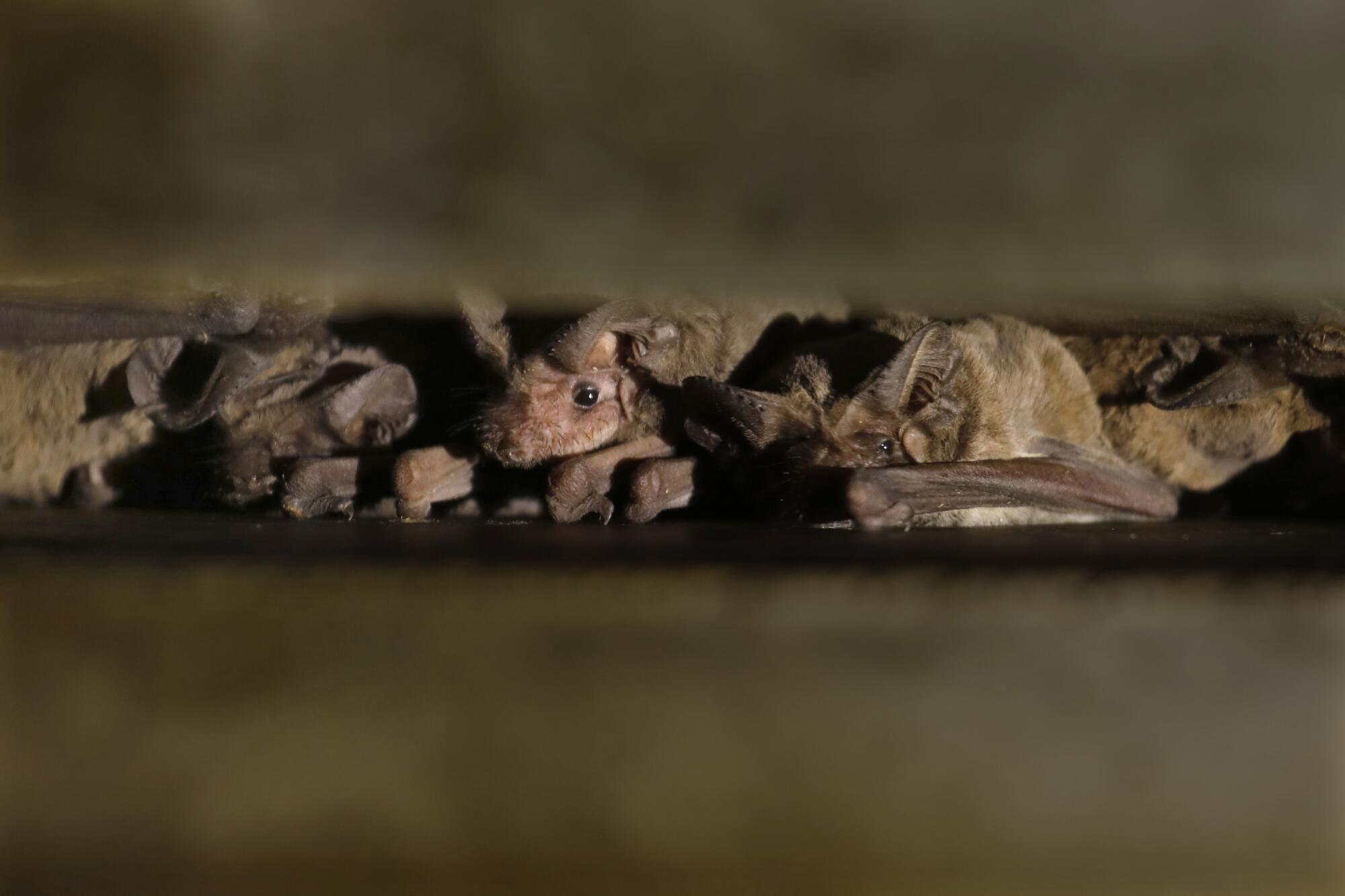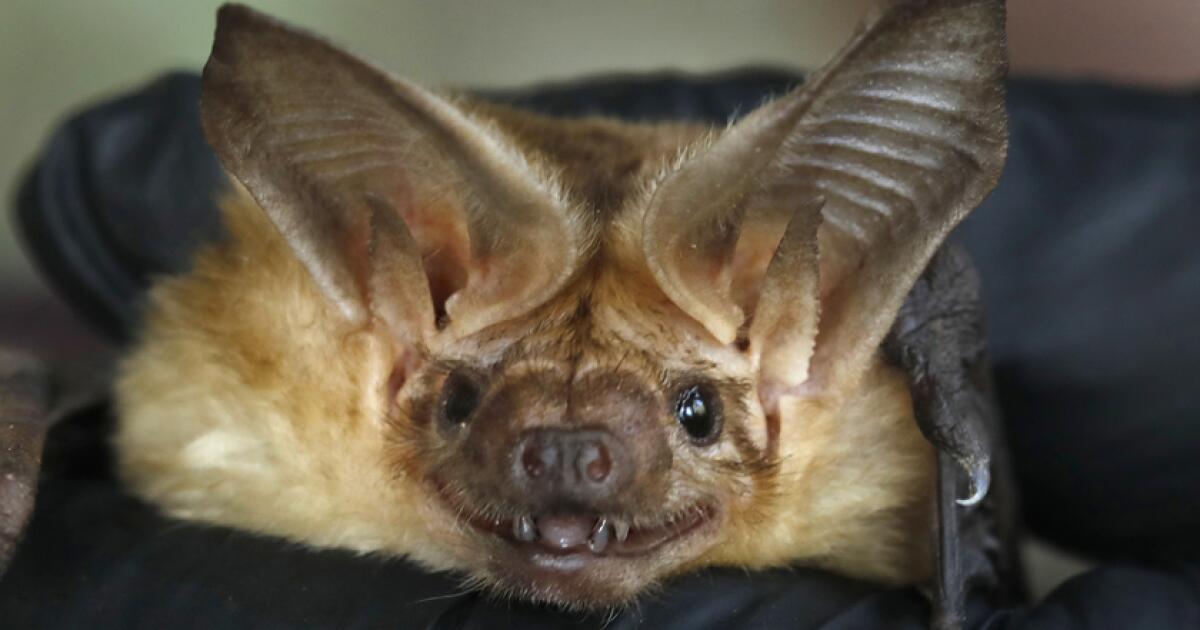A cold-loving fungus that has killed millions of bats across North America has significantly expanded its footprint in California, potentially taking hold from the northern to the southern tip of the state.
Following its first detection in the Golden State last year, the fungus is now present in five counties: Humboldt, Sutter, Placer, Amador and Inyo, according to state and federal wildlife officials. It may also be in at least six others.
Pseudogymnoascus destructans — the fungus — causes deadly white-nose syndrome, so named for the characteristic snowy fuzz that manifests on the petite faces of infected bats.
In 2022, the Biden administration declared the northern long-eared bat endangered, a last-ditch effort to save a species driven to the brink of extinction by a deadly fungus. Now the fungus is in California.
(Wisconsin Department of Natural Resources via Associated Press)
The fungus invades the skin tissue of hibernating bats and causes them to wake too often or too early during winter, depleting their precious fat stores when there’s scant food. The result is often starvation, dehydration and death.
So far, California bats haven’t been seen with signs of the disease that can also chew holes through their delicate wings and cause them to flap unwisely into the daylight, but wildlife officials believe they soon will.
“I would not be surprised if it shows up next year,” said Bronwyn Hogan, a regional white-nose syndrome coordinator for the U.S. Fish and Wildlife Service. “But I also wouldn’t be surprised if it takes three or four.”
California wildlife officials last year confirmed the presence of the fungus in a bat roost in Humboldt County, which sits on the northern coast. It marked the first definitive detection in California, although officials have documented low levels in the state dating back to the winter of 2018. Test results from this year revealed it had taken root in four more counties.
Recent tests also found low levels in San Diego and San Bernardino counties, in Southern California, as well as the far Northern California counties of Trinity, Siskiyou, Shasta and Plumas. Wildlife officials called these results “inconclusive” because they don’t consider them robust enough, but some experts see them as writing on the cave walls.
“Those early kind of signals can be helpful for understanding the progression of the fungus, of where it’s getting to,” said Winifred Frick, chief scientist at Bat Conservation International and an adjunct professor in ecology and evolutionary biology at UC Santa Cruz.
Experts reacted to the news with resignation. Hogan said she was “bummed,” but the expansion of the fungus wasn’t unexpected. Scientists have known the fungus was hanging out in low levels in several places across the state for years. And they’ve upped their surveillance.
California and federal wildlife officials, along with other partners, work closely on efforts to check for the fungus and disease through sampling and observation. This year, biologists collected samples from nine sites in California, swabbing the diminutive animals’ noses and forearms, said Katrina Smith, statewide coordinator for small mammal conservation for the California Department of Fish and Wildlife.
The fungus has appeared on a number of California’s 25 bat species, including the little brown myotis, Yuma myotis, long-legged myotis, big brown bat, Mexican free-tailed bat, and — for the time ever documented — a Western red bat.

Mexican free-tailed bats fill the sky in San Antonio.
(Bob Dean / Views of Nature Photography / Bat Conservation International)
There’s a flare of science fiction to the origin of white-nose syndrome. When biologists first encountered bats succumbing to the illness in caves near Albany, N,Y., in 2007, the fungus behind the destruction was unknown to science, according to federal officials. (It’s since been found on bats in Europe and Asia, where they appear to have resistance to the invader.)
No one knows how the fungus arrived in North America, but it has spread rapidly across the U.S. and Canada, leaving legions of bat carcasses in its death march. Many of the victims were the little brown bat.
Scientists who were tracking the expansion were surprised when the illness popped up for the first time on the West Coast in 2016, when a hiker found a dying bat on a trail in Washington state.
“It was a big jump from where it was, kind of in the center of the country,” said Jeremy Coleman, national white-nose syndrome coordinator for the U.S. Fish and Wildlife Service.
Officials estimate that more than 6 million bats have perished across the U.S. from the syndrome as of 2012. The toll now is probably higher and officials are working on an update. (The fungus is not known to cause illness in humans or other animals, according to officials.)
California’s bats are more elusive than those to the east that can amass in the thousands in caves and mines. It’s believed Golden State bats are clustering in smaller numbers in rock crevices, swaying palm fronds, freeway underpasses and other hideaways where they’re hard to find.
The West Coast particularity may be a blessing and a curse. On one hand, the diffusion of bats across the landscape could slow the march of white-nose syndrome, which is primarily spread between bats when they groom or touch each other.
However, it makes it hard to know what’s going on with them.
“There’s some hope that maybe the disease could have less dramatic impact here, but it may also just be harder to measure that impact,” Frick said.
In areas where bats congregate in large groups, scientists can simply trek out to caves they’re known to frequent and count them to see if they’re dying off.
Coleman said the illness typically shows up one to two years after the fungus is detected.
“Unfortunately, now that it’s in California, from what we know, from all the other sites where we’ve seen the fungus spread, disease will follow at some point,” he said.
Bats, the only flying mammals, provide no-cost pest control by gobbling up insects — including ones that target crops. Their annual national contribution to farmers is an estimated $3.7 billion. Their guano, or dung, can also be used as fertilizer.
In California, there are currently discussions about the possibility of vaccinating bats. Vaccinations could improve the winged creatures’ chances of surviving the onset of white-nose syndrome, according to Smith, but injecting individual bats is laborious.
“It just offers a chance for some of the individuals to build resilience to the disease, and hopefully over time, that some of them survive and find ways to make it through,” she said.
They’re also awaiting results on other possible options, like probiotic powders that may strengthen bats’ skin microbiomes to slow fungal growth. Researchers have tested out blowing probitoic-laden dust into bat roosts when they vacate for the night, allowing it to coat them when they return.

A colony of Mexican free-tailed bats living under the Yolo Bypass Wildlife Area.
(Carolyn Cole / Los Angeles Times)
Some bat boosters are taking more creative approaches.
Bat Conservation International, a nonprofit, has launched the Fat Bat Project, which seeks to help the furry mammals pack on the ounces before and after winter sets in.
Because white-nose syndrome causes bats to shed fat during hibernation, the idea is that heftier bats will better withstand the often fatal physiological disruption, according to Frick.
The nonprofit is testing out a method where a UV light is set up to attract bugs to bats near the hibernacula, the cool-sounding plural for bat refuges.
“We like to call it our bug buffet,” Frick said.
Members of the public are urged to report sightings of sick or dead bats — or those acting abnormally, such as flying during the day — to California wildlife officials. People, however, should not handle the animals.


